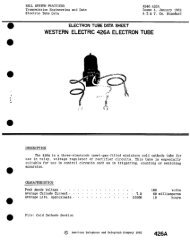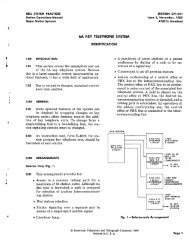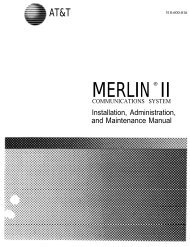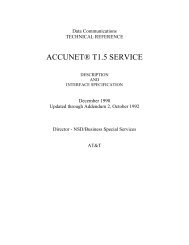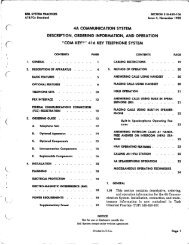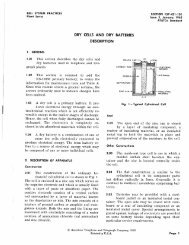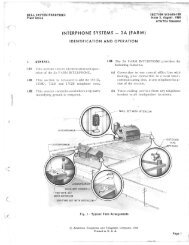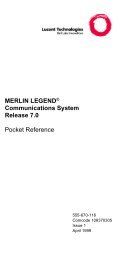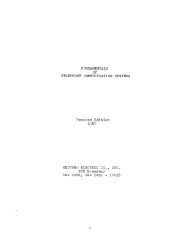COMMON LANGUAGE LOCATION IDENTIFICATION (CLLI) CODE ...
COMMON LANGUAGE LOCATION IDENTIFICATION (CLLI) CODE ...
COMMON LANGUAGE LOCATION IDENTIFICATION (CLLI) CODE ...
You also want an ePaper? Increase the reach of your titles
YUMPU automatically turns print PDFs into web optimized ePapers that Google loves.
guage Location Identification (<strong>CLLI</strong>) purposes,<br />
nonbuilding locations may include:<br />
• International Boundary Crossing Points<br />
• End Points<br />
• Junctions<br />
• Manholes<br />
• Poles<br />
• Radio Locations<br />
• Toll Stations<br />
• Independent Telephone Company Owned<br />
Nonbuilding Locations<br />
• Customer Locations<br />
• Miscellaneous Nonbuilding Locations.<br />
7.04 Nonbuilding locations are assigned codes according<br />
to the place and state in which they<br />
are geographically located. If the nonbuilding location<br />
is outside the boundaries of all identified<br />
places, it should be assigned to the nearest place<br />
within the state.<br />
7.05 When there is a requirement to identify the<br />
structure in which or on which a nonbuilding<br />
entity is located, use the Building Code described in<br />
Part 5 of this Section. For example, a Building Code<br />
may be assigned to a Microwave Radio Relay Building<br />
if switching or nonswitching entities within the<br />
building must be identified. In this case, the code represents<br />
building location, not a radio location. Refer<br />
to Figures 2d and 2g in Part 10.<br />
7.06 No attempt should be made to identify<br />
nonbuilding locations as entities within a<br />
building.<br />
B. Bell Operating Company Nonbuilding Locations<br />
(Character Positions 7 through 11)<br />
International Boundary Crossing Points - B(n) (n) (n) (n)<br />
7.07 A location on a border between two adjacent<br />
countries is assigned a "B" in character position<br />
7 followed by 4 numeric characters.<br />
Example:<br />
ISS 5, SECTION 795-100-100<br />
NONBUILDING <strong>LOCATION</strong> <strong>CODE</strong> CUI FORMAT<br />
Sault St. Marie (Michi- B2232 SSMRMIB2232<br />
gan)<br />
- Ontario (Canada) International<br />
Boundary<br />
Crossing Point<br />
End Point Locations-E(n) (n) (n) (n)<br />
7.08 An End Point is defined as a location in the<br />
network where two or more trunk facility<br />
routes converge or cross with no cross-connection<br />
capability. The end point format may also be used to<br />
identify locations where facilities cross state, province,<br />
or company boundaries. The end point code is<br />
assigned an "E" in character position 7 followed by<br />
4 numeric characters.<br />
Example:<br />
NONBUILDING <strong>LOCATION</strong> <strong>CODE</strong> CUI FORMAT<br />
A specific splice on a pole E2345 JRCYNJE2345<br />
between 2 spans<br />
Junction Locations-J(n) (n) (n) (n)<br />
7.09 A Junction is defined as a location in the facility<br />
network with cross-connection capability,<br />
and is identified by the character "J" in character<br />
position 7 followed by 4 numeric characters.<br />
Example:<br />
NONBUILDING <strong>LOCATION</strong> <strong>CODE</strong> CUI FORMAT<br />
Cross-connect box 29-A J2345 KLG RNEJ2345<br />
The Junction code should not be used to identify the<br />
manhole or pole where the junction is located. Refer<br />
to manhole and pole code formats.<br />
Manhole Locations-M(n) (n) (n) (n)<br />
7.10 Manhole locations are identified by assigning<br />
the character "M" to character position 7 followed<br />
by 4 numeric characters.<br />
Page 15







